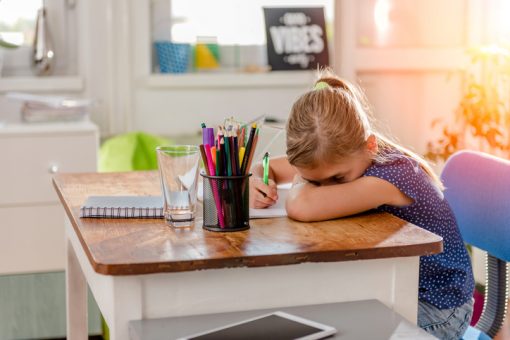An anxiety disorder is characterized by an irrational, persistent, and overwhelming sense of fear and worry that interferes with daily activities. Anxiety disorders affect 25.1% of children between 13 and 18 years old and can commonly co-occur with depression, eating disorders, and attention-deficit/hyperactivity disorder (ADHD). Anxiety disorders in children can prevent them from making friends, raising their hand in class or participating in social and school activities. If left untreated, anxiety disorders in children can lead to poor academic performance, low self esteem and potentially substance abuse in order to deal with their feelings associated with anxiety. Anxiety is usually a normal phase of childhood and children may practice strange patterns such as counting in fives, only wanting to eat one type of food or wear only one color of clothing. They may have imaginary friends or may need sunglasses to help them become invisible. The difference between a phase and an anxiety disorder is that a phase is temporary and is usually harmless. Children who suffer from an anxiety disorder experience fear, nervousness, shyness, and avoidance of places and activities over a long period of time and neither parents nor teachers are able to help. When a child becomes anxious around a loving parent, this should raise some suspicion.
Normal developmental anxiety phases
The nature of anxieties and fears change as kids grow and develop:
- Babies experience stranger anxiety, clinging to parents when confronted by people they don’t recognize.
- Toddlers around 10 to 18 months old experience separation anxiety, becoming emotionally distressed when one or both parents leave.
- Kids ages 4 through 6 have anxiety about things that aren’t based in reality, such as fears of monsters and ghosts.
- Kids ages 7 through 12 often have fears that reflect real circumstances that may happen to them, such as bodily injury and natural disaster.
Signs and symptoms associated with children that have anxiety disorder
The term “anxiety disorder” refers to a group of mental illnesses that includes generalized anxiety disorder (GAD), obsessive-compulsive disorder (OCD), panic disorder, posttraumatic stress disorder (PTSD), social anxiety disorder, selective mutism and specific phobias. Each anxiety disorder has its own set of specific symptoms and list of diagnostic criteria however they all have some of the same underlying general signs and symptoms. The following signs and symptoms are associated with anxiety disorders:
- Excessive worry
- Irritability
- Difficulty concentrating
- Difficulty sleeping
- Nausea
- Social isolation
- Heart palpitations
- Inability to relax
- Unwillingness to participate in school
- Headaches
- Stomach aches
- Sweaty hands
- Impulsive behavior
- Clingy behavior
- Fear out of sense of proportion
Seeking treatment for your child’s anxiety
Like other medical conditions, anxiety disorders tend to be chronic unless properly treated. Most children find that they need professional guidance to successfully manage and overcome their anxiety. Although family support is important for the recovery process, it is not the cure. If your son or daughter is experiencing any of these signs or symptoms of anxiety for a long duration of time, seeking professional help is highly recommended. Parents should be looking for abnormal patterns that are persistent or pervasive. If you are unsure about these signs and symptoms, speaking to your child’s teachers or other caretakers about what they have experienced with your child may give you more insight into what your child is experiencing. Cognitive behavior therapy, also known as talk therapy, and medication management are the mainstays of treatment for anxiety in children. It is important to seek a professional who is trained in cognitive behavior therapy and who works with children and adolescents. Your family doctor or pediatrician should be able to refer you to a treatment specialist if you are not able to find one through other avenues.
More from Discovery Mood & Anxiety Program
